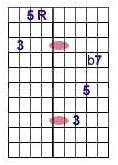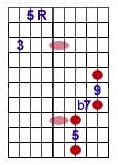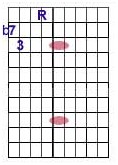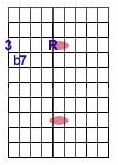







© 2011 Bob Culbertson
Chord Stacking Part 2
In this lesson we will study the Dominant 5 chord. To do this lesson you should have an understanding of basic jazz chord theory.
The dominant chord has the most variations of any chord. The most common variations involve using a b5, #5 or a b9, #9, or any combination there of. This is true because the 5 chord usually resolves to the 1 chord. The altered 5th or 9th create a "half step tension effect" to be resolved at the root chord. If you don't quite understand what I just said don't worry, here are some ways to play those chords.
Of course the parts of a dominant chord are as follows (Root, major 3rd, 5th, b7th) notice that the distance between the 3rd, 5th, and 7th are all minor thirds. Our first chord to play is a simple C7. Play Cmaj in the bass and Edim in the melody Fig1
In this lesson we will study the Dominant 5 chord. To do this lesson you should have an understanding of basic jazz chord theory.
The dominant chord has the most variations of any chord. The most common variations involve using a b5, #5 or a b9, #9, or any combination there of. This is true because the 5 chord usually resolves to the 1 chord. The altered 5th or 9th create a "half step tension effect" to be resolved at the root chord. If you don't quite understand what I just said don't worry, here are some ways to play those chords.
Of course the parts of a dominant chord are as follows (Root, major 3rd, 5th, b7th) notice that the distance between the 3rd, 5th, and 7th are all minor thirds. Our first chord to play is a simple C7. Play Cmaj in the bass and Edim in the melody Fig1

FIG 1
Now if you extend to the next note (the 9th) you would play Cmaj in the bass side and Gminor in the melody. This of course is C9. Now here is a cool trick. Notice that the root of the melody chord is the note G (the 5th of the C9) and the 5th of the melody chord (D)is the 9th. From these 2 notes you can get all of the common altered voicings just by moving the note up or down 1/2 step. Fig2 shows the 4 altered chords. The red dots represent the altered note. For example if you move the 5 down 1/2 step you get C7b5. Or if you move the 5th up 1/2 step and move the 9th down a 1/2 step you get C7#5b9.
Note: Be careful of the bass hand (If you are playing a 5th in the chord you must either take it out, sharp or flat it according to the chord in the right hand). A nice chord voicing to play in the bass is a C7 or G7 shown in Fig3. This voicing has no 5th. It is great for playing all kinds of altered voicings using the melody chord on top...
Note: Be careful of the bass hand (If you are playing a 5th in the chord you must either take it out, sharp or flat it according to the chord in the right hand). A nice chord voicing to play in the bass is a C7 or G7 shown in Fig3. This voicing has no 5th. It is great for playing all kinds of altered voicings using the melody chord on top...
FIG 2




FIG 3